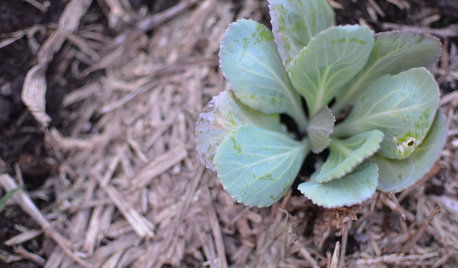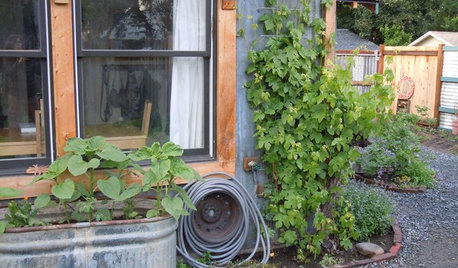In pursuit of the squash bugs
User
12 years ago
Featured Answer
Sort by:Oldest
Comments (44)
zzackey
12 years agoRelated Discussions
Anyone Grown Squash and not gotten SVB or Squash bugs?
Comments (61)I got tired of growing pumpkins and squash that were always killed by the dreaded SVB. I found an article in Mother Earth News that explained all about the moth that lays the egg that grows into the SVB..anyway if you grow Cucurbita moshata..a type of squash that has dense solid stems they are totally immune to SVB damage. I grew a Rumbo pumpkin that was wonderful. It is actually a cross between a winter squash and pumpkin. If you read the seed catalogs that give the real botanical names you can find other types as well. The Rumbo's were delicious and beautiful too. The only thing is that you can't carve them like a jack o lantern because they are dense. I got my original seeds from Jungs but Parks used to carry them too. There are also several varieties in the Baker Creek catalog as well. I attached a link to the Rumbo so you can see it. Here is a link that might be useful: Rumbo pumpkin...See MoreButternut squash resistant to squash bugs-How?
Comments (11)I only have this year to base my observations on and they didn't quite line up with what I had read. I have a long row of C. moschata with a couple of C. pepo at the end. The pepos are nominally to be a trap crop for the squash bugs since I had read that they were preferred over the moschatas. The moschatas are an experiment to see how well they stand up to svb. So far both sets of plants have been visited by both types of insect. There were pretty much the same number of adult squash bug found on both varieties on a daily basis, so it didn't seem like they preferred the pepos. The pepos have now collapsed from svb, and I haven't bothered to try to save them having had my annual dose of summer squash. They were always destined to be trashed anyway. The moschata have evidence of svb damage on the stems but are not (yet anyway) collapsing. So moschatas being svb resistant? Check. C. pepo being preferred by squash bugs? Doesn't seem like it this year. Bu tlike I said, it's only one year....See MoreLeaf footed bugs, stink bugs and squash bugs
Comments (2)I think hand picking or vacuuming adults, planting beneficial-insect-attracting flowers, and using row covers on the grow beds are your best options for control. The following methods of control are quoted directly from "The Organic Gardener's Handbook of Natural Insect and Disease Control" CONTROL METHODS: Squash Bugs - Maintain vigorous plant growth; handpick all stages of squash bugs from undersides of leaves; support vines off the ground on trellises; attract native parasitic flies with pollen and nectar plants; cover plants with a floating row cover (you'll need to hand-pollinate flowers. Stink Bugs - Control weeds in susceptible crops; remove or mow weedy areas adjacent to garden beds; attract native parasitic wasps and flies by planting small-flowered plants. As a last resort, dust with pyrethrin....See MoreSquash bugs or (U)squash(/U) bugs or (S) use Ortho Bug Be Gone(/S
Comments (16)Granny, until recently I was totally organic in the garden. When I would have an infestation of some kind, the organic correction was only marginally successful. I do not know if it was just me or my location or what. I wish these various links would define what they mean when they say "control". I assume they mean that you bring the population down to an acceptable level. To me an acceptable level is one, either male or female but not both. I see my only options right now as being, use BBG or not growing squash for a couple of years. I am so upset over this that I am going to have an IT instead of a BM. Ok so I told one little lie. :o) John Here is a link that might be useful: Johns Journal...See MoreUser
12 years agowayne_5 zone 6a Central Indiana
12 years agoUser
12 years agohcoon
12 years agoUser
12 years agoUser
12 years agozzackey
12 years agoUser
12 years agogardenweasel2009
12 years agoUser
12 years agozzackey
12 years agoUser
12 years agoglib
12 years agoNancyPlants
12 years agoKassaundra
12 years agoNancyPlants
12 years agoNancyPlants
12 years agotracydr
12 years agocarolync1
12 years agochuckby
12 years agoUser
12 years agowayne_5 zone 6a Central Indiana
12 years agoUser
12 years agoglib
12 years agoNancyPlants
12 years agoUser
12 years agodancinglemons
12 years agozzackey
12 years agoUser
12 years agoKassaundra
12 years agoUser
12 years agoerin_nc
12 years agoNancyPlants
12 years agoNancyPlants
12 years agoNancyPlants
12 years agoNancyPlants
12 years agoUser
12 years agotomva
12 years agoUser
12 years agoJay5
12 years agoUser
12 years agoSid23
12 years ago
Related Stories

EDIBLE GARDENSSummer Crops: How to Grow Squash
Almost foolproof and with cheerful flowers, squash comes in a wide range of varieties to plant in spring
Full Story
FARM YOUR YARDHouzz Call: Home Farmers, Show Us Your Edible Gardens
We want to see where your tomatoes, summer squashes and beautiful berries are growing this summer
Full Story
REGIONAL GARDEN GUIDESMid-Atlantic Gardener's September Checklist
Squash, anyone? Cool-season veggies are suiting up for the garden, while summer's last blooms are winding down
Full Story
STUDIOS AND WORKSHOPS11 Tips to Get the Creative Space You Crave
Life, liberty and the pursuit of your craft. OK, that's paraphrased, but we think you have the right to an inspiring workspace of your own
Full Story
EDIBLE GARDENSGarden BFFs? Why Your Vegetables Are Begging for Companion Plants
Foster friendships among plants for protection from pests, pollination support and color camaraderie
Full Story
CRAFTSSimple Pleasures: Crafting for Fun and Relaxation
Recharge the unplugged way during downtime with crafts and building projects, alone or in a group
Full Story
EDIBLE GARDENSSummer Crops: How to Grow Pumpkins
Start in spring to grow your own fall decorations and have plenty left for pies
Full Story
GARDENING GUIDESEdible Gardening Essentials: Tips for Traditional Hand Watering
Save the expense and hassle of a complicated garden system with a simple watering can or inexpensive hose add-ons
Full Story
BENEFICIAL INSECTSAttract Pollinators for a Productive Edible Garden
You can lure bees, butterflies and birds into your yard with the right flowers and nesting spots
Full Story
VINTAGE STYLEMy Houzz: ‘Pavement Pickings’ a Happy Fit in a Period Home
An eclectic array of antiques and vintage items adds to the charm and character of this Melbourne home
Full StorySponsored
Industry Leading Interior Designers & Decorators in Franklin County




laceyvail 6A, WV